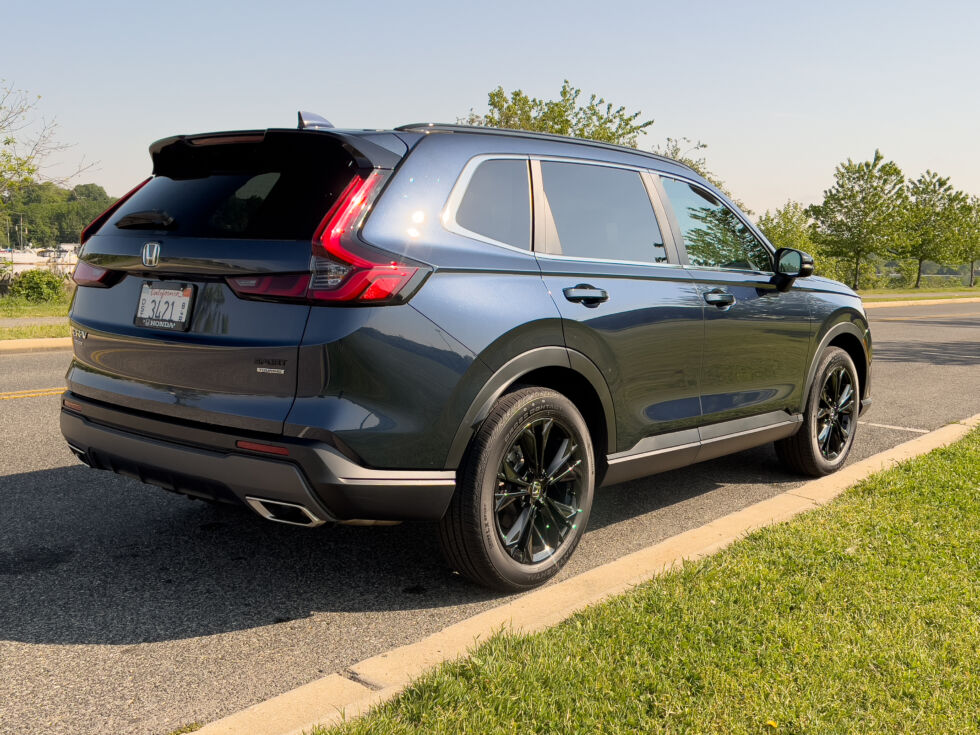
Honda has a new version of its bestselling CR-V, the sixth to bear the name. Like many waistlines following the pandemic, it's slightly larger than the old CR-V. But don't let size matter—the $32,950 Sport version (or the $34,450 Sport AWD) features a hybrid powertrain capable of up to 40 mpg (5.9 L/100 km), and relative to the competition, it's even capable of being an engaging drive.
It seems a little odd, knowing that this Honda is now in its sixth generation, a fact that speaks as much to the supremacy of the SUV within American driving culture as it does to my changing perception of time as I age. The new CR-V hews to Honda's current corporate face, with bold hexagonal grille and headlights and daylight running lights that slash up to the tops of the front wings.
Most of what used to be called brightwork ought to be called darkwork for the CR-V Sport, since it's mostly made from glossy black plastic. Our test CR-V was the $39,100 Sport Touring, which boasts a little platinum-painted flair on the front that appears to glow when it catches the light right.
Despite adding a little length and width, the CR-V is still not ginormous. At 184.8 inches (4,694 mm) long and 73.5 inches (1,867) wide, its footprint isn't much bigger than the Toyota Prius we just tested—certainly, this is no Hummer EV-scale vehicle. Unlike the Prius, at 66.5 inches (1,689 mm), the CR-V was not towered over by the Volvo XC40 or BMW X5 that live in the parking spaces adjacent to mine.

The hybrid powertrain doesn't have quite as long a family tree, but this is Honda's fourth-generation two-electric motor system. It pairs a 2.0 L four-cylinder engine with two electric motors—one to drive the wheels, the other to charge the hybrid battery.
The engine is actually rather advanced. As you may expect, it uses the more efficient Atkinson cycle and features multi-stage fuel injection to create a more homogeneous fuel-air mixture and, therefore, more complete combustion. Honda has a long history of using this kind of technology, all the way back to the Civic CVCC of 1972. As a fan of interesting technical solutions to problems, I'm glad to see it continue to evolve.
Honda says the new CR-V Sport's engine has a thermal efficiency of 41 percent, which is about as high as you might find outside of a Formula 1 racecar. Honda has a long history of building engines for those things, too.
The gasoline engine generates 145 hp (108 kW) and 138 lb-ft (Nm) and spends almost all of its time driving the 161 hp (120 kW) power generator, one of the two electric motors in the powertrain. That generator, in turn, charges the 1 kWh traction battery. And that battery powers the traction motor, which is more powerful and offers much more torque than the internal combustion engine, with 181 hp (135 kW) and 247 lb-ft (Nm) available.

There is no transmission, but under some circumstances, the CR-V's engine can also send torque to the wheels. This can occur at highway speeds when a clutch engages the traction motor to the generator, allowing the engine's power to reach the wheels, too. The fact that the Chevrolet Volt could also do this would, for some reason, enrage some EV enthusiasts, and I expect them to be outraged that the CR-V also splits the difference between being a parallel and series hybrid. The combined power output is 204 hp (152 kW).
reader comments
180